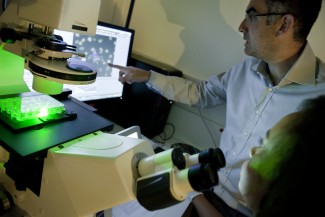Thanks to a screening, Xavier Nissan’s team of the Institute for Stem cell Therapy and Exploration of Monogenic diseases (I-stem) has identified a compound able to treat progeria, a rare genetic disease inducing premature aging.

Xavier Nissan at I-stem, the Institue for Stem cell Therapy and Exploration of Monogenic diseases.
A world premiere.
The study was conducted with sick induced pluripotent stem cells (or iPSCs). The adult cells “rejuvenated” acting like their human embryonic counterparts.
However, obtaining a line is a great success, because “so far, cellular patterns of this disease showed replicative senescence [that is to say they could not replicate indefinitely, ed.], which prevented any molecules screening “said Xavier Nissan.
Once this “eternal” line available, the team of I-stem has been able to differentiate the iPSCs into bone cells and blood vessels, two of the most affected tissues by the disease.
Then, 22,000 compounds had to be tested. This time again, it was a real challenge.
“This is the first time that such a high-throughput screening is performed on sick iPSCs” add the Scientist. Finally, three compounds turned out to be effective at non-toxic therapeutic doses.
“We have called them mono-diaminopyrimidines (mono-APs), said Xavier Nissan. “Then we have identified their mechanism of action.”
And it turns out that “mono-APs also prevent farnesylation of oncogenes [genes involved in cancers, ed.]. They could be used to replace farnesylation inhibitors being tested in the treatment of some leukemias. In other words, this is another model showing that research on rare diseases can also open up new therapeutic prospects for more common diseases.”

